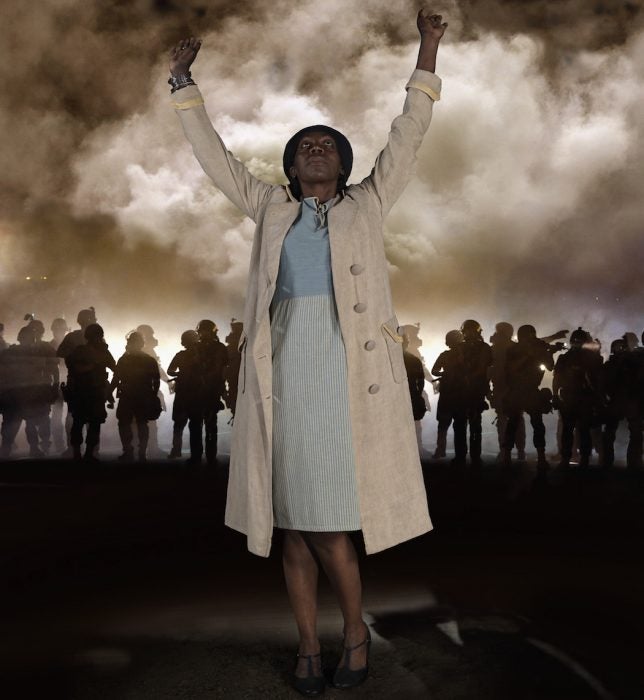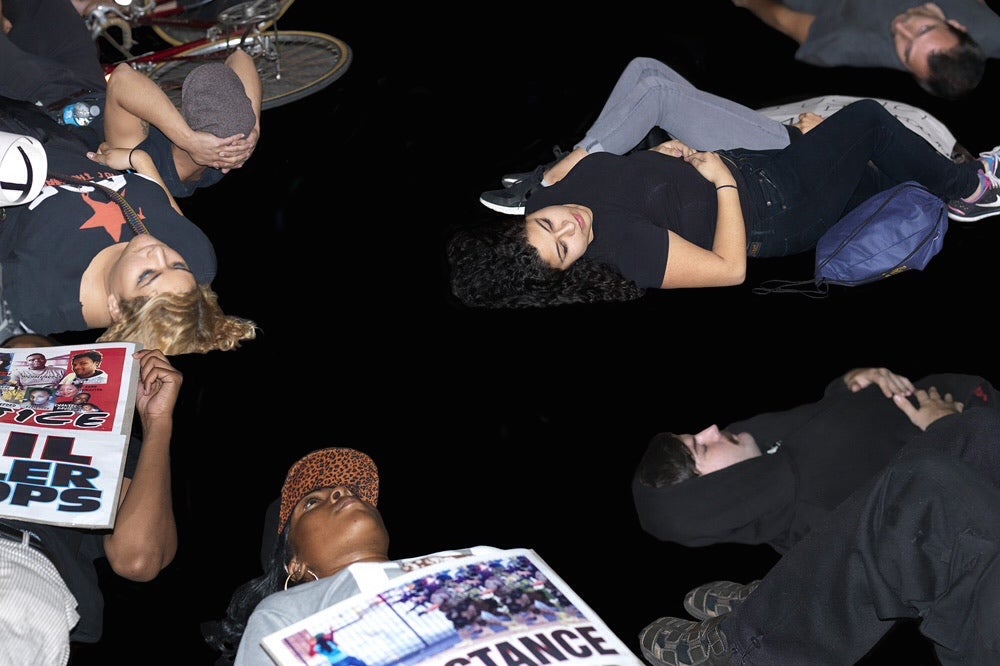In this WNYC interview, art critic Deborah Solomon names die-in photos the best art of 2014. Since the deaths of Michael Brown and Eric Garner, people across the U.S. have been staging die-ins to silently protest the deaths, subsequent acquittal of Darren Wilson, and non-indictments of the NYPD. Protestors use their physical bodies as both a stand-in for the victims’ bodies and a jarring reminder of lives lost.
In her proclamation about the art of die-in photography, Solomon acknowledges the artistic look and power of Twitter-generated photos of and by citizen journalists/artists, saying, “I don’t believe in labeling visual images art or non-art. There are images that move us, that rouse us to action, and the best protest photographs belong to that category.”
Artist Ken Gonzales-Day also saw the power and potential of these raw protest photos, in using them as source photos for his own art. In “Run Up” at Luis de Jesus Los Angeles, Gonzales-Day appropriates and manipulates his own photos taken from protests in Ferguson and LA and combines them with his own conceptual art to visually trace the roots of our political unrest. Emphasizing collective violence and resistance through mob mentality, police presence, and protests, Gonzales-Day ties present-day racial tensions to a lesser known history of lynchings.
With this latest work, Gonzales-Day continues his ever-growing project to interrogate the historical archive through art and imagery. As a photographer and scholar, his research often documents and reflects upon photography’s historical use, while his work offers new avenues for the medium itself. In Leonardo, Gonzales-Day writes, “Some of the earliest applications of photography involved attempts to correlate the functioning of the human mind with the appearance of the human body. Phrenology, eugenics, early psychology, physiognomy and criminology all made use of photographic techniques.”
This darker history of photography inspired his series “Profiled.” He began by photographing museums’ anthropological sculptures and then he then pitted them against one another as if in conversation or heated debate. These pairings visualized and questioned the emergence of pseudo scientific studies of race. Like much of his work, he explains in Getty Research Journal:
This portfolio includes a number of profiles, rendered by the sculptor in black or white, but depicting different racial categories whose juxtaposition here serves to foreground the arbitrary nature of racial classification…Their significance lies not only in the histories they represent but also those which remain lost in shadow, unseen but no less present.
His latest installment of the “Erased Lynchings” series foregrounds his research on a nearly forgotten history of lynchings which found that more Latinos than any other race were lynched in the West. In “Run Up,” Gonzales-Day interweaves characters from a restaging of the 1920 lynching of a Latino man named Charles Valento with the current protest photographs, collapsing the past and present to pose questions about the U.S. justice system.
In Hands Up (below), a 1920s female witness to the lynching stands monumentally in the foreground, looking to the sky with her hands held high, while a line of Stormtrooper-like police stand behind her, shrouded in mist and riot gear (from an actual photograph, taken in Ferguson). Her 1920s clothing and presence forcefully suggest that police shootings are the new lynchings, while also valorizing the role of resisting, bearing witness, and protesting in our present moment.
Die-in, Los Angeles, CA (above) features somber bodies lying on a solid, dark background; the artist has blacked out the street to emphasize the bodies, the physicality, and the reminder that they stand-in for those who have been killed unjustly. The Society for Linguistic Anthropology recently called for silent meditation as an alternative response to Brown and Garner’s deaths. Ken Gonzales-Day channels this concept through both his art and research, demanding somber, quiet, reverence and contemplation, outrage and resistance.








